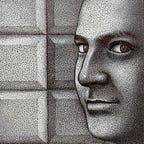GridWhale Demo
I love programming. Sometimes, all the pieces of a program click in your head, and you pour out the code through the click-clack rhythms of the keyboard. You’re like an athlete gliding through the field, or an artisan wielding a tool with precision and grace. You feel at one with your task.
But other times, it’s a slog. In my last post I talked about the complexity of modern software systems. The solutions and services that we’re building today are inherently distributed. We’re writing a menagerie of cooperating programs: a front-end user interface program talking to a back-end app program, in turn talking to a constellation of microservice programs and database programs. The complexity is exhausting.
We have to do it this way because of scalability. A single piece of hardware could never support all the users of, for example, Gmail. We distribute the load across thousands of machines. Each machine talks to other machines in a complex grid of computation. And programmers make it all work with an ecosystem of frameworks, paradigms, and abstractions.
But what if we had a single, super-powerful machine? What if the UI, data, and files for millions of users were all on the same machine? Programs would be a lot simpler because they could access everything directly, without worrying about network access, caching, or asynchronous events. No such hardware exists, of course, but what if we built a virtual super-powerful machine? What if we created an environment that behaves as a single, super-powerful machine, but under the covers implements everything on top of a massive grid of discrete computers?
For the last year I’ve been working on a project called GridWhale to explore this question. GridWhale is a virtual computer, running on multiple machines, but acting as one. Programs running on GridWhale get the best of both worlds: they’re as easy to program as on a single PC, but able to access the resources of the entire data center. There are no limits to scaling across users or datasets.
In this video I show off a working version of GridWhale. I hope the simplicity of the programming model will bring back the joys of programming, without giving up the power of modern distributed applications.
Let me know what you think:
GridWhale Listings
Are you interested in trying out GridWhale for yourself? All of the programs shown on the video are listed below. You can go to https://gridwhale.com and enter the programs yourself.
Listing 1: Hello, World!
# GridLang Programprint("Hello, World!")
Listing 2: Chat
# Chat
# Copyright (c) 2022 Kronosaur Productions, LLC.
# All Rights Reserved.using Data# Chat Log ---------------------------------------------------------
# Create a chat log and subscribe to changesvar chatLog = Data.open("chatLog", "dataQueue", { })chatLog.onchange = function (op, value) begin
print(value)
end# Intro ------------------------------------------------------------print("Chat")
print("Release 1.0")
print("")# Print current logvar oldLines = chatLog.getValue()
for i = 0 to oldLines.length -1 begin
print(oldLines[i])
end# Main loop -------------------------------------------------------var done = null
while !done beginvar line = input({
prompt = "> "
noEcho = true
})if (line == "!quit") then
done = true
elseif line == "" then
else
chatLog.push(System.username + ": " + line)
end
end
Listing 3: Database
# Table Dataset Test
# Copyright (c) 2022 Kronosaur Productions, LLC.
# All Rights Reserved.using Data
using UIschema AsteroidRecord begin
var name:String
var mass:Float64 # Mass in quadrillion tons (1e18 kg)
var meanRadius:Float64 # Mean radius in km
var minDist:Float64 # Min distance from the sun in AUs
var maxDist:Float64 # Max dist in AUs
endvar AsteroidTable = Data.open("AsteroidTable", "table", { schema=AsteroidRecord })
if AsteroidTable.getValue().length == 0 then
var Init:AsteroidRecord = [
{ name="Ceres",
mass=938.35,
meanRadius=469.73,
minDist=2.55,
maxDist=2.98 }, { name="Pallas",
mass=204.0,
meanRadius=256.0,
minDist=2.14,
maxDist=3.41 }, { name="Juno",
mass=28.6,
meanRadius=127.0,
minDist=1.99,
maxDist=3.35 }, { name="Vesta",
mass=259.0,
meanRadius=262.7,
minDist=2.15,
maxDist=2.57
}
] AsteroidTable.setValue(Init)
endUI.addCommand("Add Asteroid", function () beginvar NewAsteroid = UI.dialog(AsteroidRecord)
if NewAsteroid then
AsteroidTable.insert(NewAsteroid)
end
end)UI.addCommand("Close", function () begin
UI.stop()
end)var TableControl = UI.create("table")
TableControl.data = AsteroidTableUI.show(TableControl)
UI.run()
Listing 4: Mandelbrot
# Mandelbrot
# Copyright (c) 2022 Kronosaur Productions, LLC.
# All Rights Reserved.using Image
using UIschema MandelbrotDesc begin
var x:Float64
var y:Float64
var zoom:Float64
var cores:Int32
endvar mostRecentDesc = {
x=-0.75
y=0
zoom=3
cores=4
}
var canvas = UI.create("canvas")function MakeMandelbrot () begin # Ask the user for coordinates var desc = UI.dialog(MandelbrotDesc, mostRecentDesc)
if (!desc) then return 0 end # Sanitize input a little bit. var x = desc.x
var y = desc.y
var scale
if desc.zoom <= 0 then
scale = 0.01
else
scale = 0.01 / desc.zoom
end canvas.clearRect() # Generate Mandelbrot var coresUsed
var nodesUsed
var startTime = DateTime()
var computeTime var mandelbrot = Image.mandelbrot(x, y, scale,
canvas.width, canvas.height,
{ cores=desc.cores },
fn (progress) begin
if progress.progress == 100 begin
coresUsed = progress.cores
nodesUsed = progress.nodes
computeTime = progress.time
end
end
) print("--------------------------------------------------------")
print("Time: ", DateTime() - startTime)
print("Nodes Used: ", nodesUsed)
print("Cores Used: ", coresUsed)
print("Compute Time: ", TimeSpan(1000 * computeTime)) # Show it canvas.drawImage(mandelbrot, 0, 0) # Remember settings mostRecentDesc = desc end# Main Program ----------------------------------------------------print("Mandelbrot v1.0")UI.addCommand("Mandelbrot", MakeMandelbrot)
UI.addCommand("Close", fn () begin UI.stop() end)
UI.show(canvas)
UI.run()
About: I’m George Moromisato, a software engineer building GridWhale, a new operating environment. Every couple of weeks I’ll post an update about its development. Interested in helping out? Write to me: contact@kronosaur.com.
